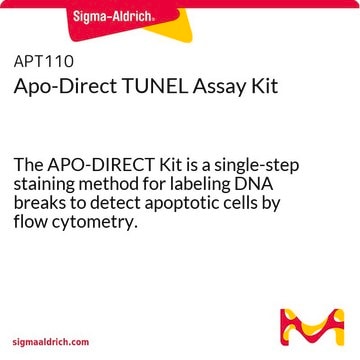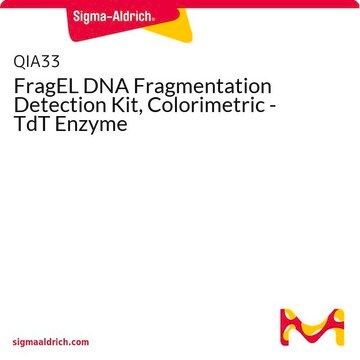Alle Fotos(1)
Wichtige Dokumente
11772457001
Roche
TUNEL AP
sufficient for 70 tests, solution, pkg of 3.5 mL
Anmeldenzur Ansicht organisationsspezifischer und vertraglich vereinbarter Preise
Alle Fotos(1)
About This Item
UNSPSC-Code:
41105600
Empfohlene Produkte
Form
solution
Verwendung
sufficient for 70 tests
Verpackung
pkg of 3.5 mL
Hersteller/Markenname
Roche
Versandbedingung
wet ice
Lagertemp.
2-8°C
Allgemeine Beschreibung
TUNEL AP is an alkaline phosphatase-labeled antibody used for the in situ detection of apoptosis (programmed cell death) with the TUNEL reaction followed by transmission light microscopy.
The tailing reaction using TdT, also named ISEL (in situ end labeling) or TUNEL (TdT-mediated dUTP nick end labeling), has several advantages in comparison to the in situ nick translation (ISNT) using DNA polymerase:
- Label intensity of apoptotic cells is higher with TUNEL compared to ISNT, resulting in an increased sensitivity.
- Kinetics of nucleotide incorporation is very rapid with TUNEL compared to the ISNT.
- TUNEL preferentially labels apoptotic cells compared to necrotic cells.
Anwendung
TUNEL AP is an antibody that is used to convert fluorescence-based TUNEL assays into colorimetric assays suited for light microscopy. The conversion is performed by binding of an anti-fluorescein antibody to FITC-dUTP. The antibody is labeled with alkaline phosphatase (AP). The AP is visualized with a precipitating substrate, such as Fast Red or NBT/BCIP.
Komponenten
Anti-fluorescein antibody, Fab fragment from sheep, conjugated with alkaline phosphatase (AP). Ready-to-use solution.
Sonstige Hinweise
For life science research only. Not for use in diagnostic procedures.
Signalwort
Warning
H-Sätze
Gefahreneinstufungen
Skin Sens. 1
Lagerklassenschlüssel
12 - Non Combustible Liquids
WGK
WGK 1
Flammpunkt (°F)
No data available
Flammpunkt (°C)
No data available
Hier finden Sie alle aktuellen Versionen:
Besitzen Sie dieses Produkt bereits?
In der Dokumentenbibliothek finden Sie die Dokumentation zu den Produkten, die Sie kürzlich erworben haben.
Kunden haben sich ebenfalls angesehen
R Gold et al.
The journal of histochemistry and cytochemistry : official journal of the Histochemistry Society, 41(7), 1023-1030 (1993-07-01)
Since DNA fragmentation is a key feature of programmed cell death (PCD) and also occurs in certain stages of necrosis, we have adapted the methodology of in situ nick-translation (ISNT) to detect DNA fragmentation on a single-cell level. We first
Beina Chen et al.
Communications biology, 5(1), 105-105 (2022-02-05)
Stroke causes degeneration and death of neurones leading to the loss of motor function and frequent occurrence of cognitive impairment and depression. Lithium (Li+), the archetypal mood stabiliser, is neuroprotective in animal models of stroke, albeit underlying mechanisms remain unknown.
Wu Jiang et al.
Clinical and experimental pharmacology & physiology, 49(1), 122-133 (2021-09-09)
Previous studies reveal that hydrogen sulphide (H2 S) exerts neuroprotection against neurotoxin-induced Parkinson's disease (PD), but the underlying mechanism remains elusive. The present study was aimed to investigate whether H2 S inhibits neuronal apoptosis of substantia nigra with the involvement
W Gorczyca et al.
Cytometry, 15(2), 169-175 (1994-02-01)
The predominant mode of either spontaneous or drug-induced death of cells in tumors is apoptosis. A flow cytometric method was developed in our laboratory to identify apoptotic cells, based on labeling DNA strand breaks, which appear as a result of
Simultaneous determination of cell surface antigens and apoptosis.
R Sgonc et al.
Trends in genetics : TIG, 10(2), 41-42 (1994-02-01)
Unser Team von Wissenschaftlern verfügt über Erfahrung in allen Forschungsbereichen einschließlich Life Science, Materialwissenschaften, chemischer Synthese, Chromatographie, Analytik und vielen mehr..
Setzen Sie sich mit dem technischen Dienst in Verbindung.











